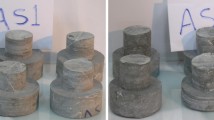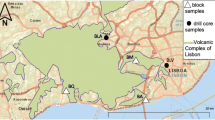Abstract
In competent rock masses submitted to low shear stress (e.g., close to the surface), stability is controlled by the geometry of blocks and strength of the discontinuity planes that separate the blocks. The basic friction angle is a relevant parameter to estimate shear strength of discontinuities. The most employed technique to determine the basic friction angle is the tilt test, which can be applied in laboratory settings or in situ, utilizing two blocks of rock that are tilted until the top block slides. No studies on the determination of basic friction angle in field settings were found for specific volcanic rocks such as andesites, dacites and rhyolites, which are typical of the acid and intermediate volcanism of Andean mountain range volcanoes. Rhyodacitic rocks of the Potosí mine, in Bolivia, were selected for basic friction angle characterization in situ. Cerro Rico is 4782 m high, and has been declared a humanity heritage site along with the city of Potosí in 1987, being one of the most important silver mines in the world. Cerro Rico is constituted by an intrusion of dacitic volcanic rocks with silver and tin mineralization. The results of the study agree with basic friction values of intrusive rocks with similar texture. It is highlighted that this simple field methodology is useful and effective to obtain preliminary values of shear strength for discontinuities. The obtained values of basic friction for rhyodacite add to the database of geomechanical rock characterization.





Similar content being viewed by others
Change history
15 March 2018
The published online version captured incorrect author name due to Spanish family name mistake. Raquel Herrera Espada should be Raquel Herrera. Corrected author name is provided in the author group section above.
References
Alejano LR, Gonzalez J, Muralha J (2012) Comparison of different techniques of tilt testing and basic friction angle variability assessment. Rock Mech Rock Eng 45:1023–1035. https://doi.org/10.1007/s00603-012-0265-7
Aranibar A M, and Mancilla B I (2003) Potosí Patrimonio minero, In: Patrimonio geológico minero en el contexto de cierre de minas, Villa Boas, Martínez, Albuquerque (Eds) CYTED, ISBN 85–72271686: 97–110
Barton NR (1973) Review of a new shear strength criterion for rock joints. Eng Geol 7:287–332
Barton NR (1976) The shear strength of rock and joints. Int JMech Min Sci Geomech Abstr 13(10):1–24
Barton N (2014) Shear strength of rock, rock joints, and rock masses: problems and some solutions. Keynote lecture, Eurock, Vigo, 2014 Rock Engineering and Rock Mechanics: Structures in and on Rock Masses, Alejano, Perucho, Olalla and Jiménez (Eds) Taylor and Francis, London: 3–16
Barton NR, Bandis SC (1982) Effects of block size on the shear behaviour of jointed rock. 23rd US Symp on rock mechanics, Berkeley, pp 739–760
Barton N R, Bandis SC (1990) Review of predictive capabilities of JRC-JCS model in engineering practice. In rock joints, proc. int. symp. on rock joints. Loen. Norway (eds. N. Barton and O. Stephansson). 603–610. Rotterdam: Balkema
Barton NR, Choubey V (1977) The shear strength of rock joints in theory and practice. Rock Mech 10(1–2):1–54
Barton N, Bandis S, Bakhtar K (1985) Strength, deformation and conductivity coupling of rock joints. Int J Rock Mech Min Sci Geomech Abst 22(3):121–140
Coulson J H (1972) Shear strength of flat surfaces in rock. Proc 13th Symposium on Rock Mechanics, Urbana, I L, 1971 (Ed. Cording E J): 77–105
Cunningham CG, Zartman RE, MeKee EH, Rye RO, Naeser CW, Sanjinés VO, Ericksen VGE, Tavera VF (1996) The age and thermal history of Cerro Rico de Potosi, Bolivia. Mineral Deposita 31:374–385
Deere D U, Miller R P (1966) Engineering classification and index properties of rock. Technical Report N° AFNL-TR-65-116. Albuquerque, NM. Air Force weapons laboratory
García-Guinea J (1995) Cerro Rico in-mine museum project. Potosí, Bolivia, Min Ind Int 1026:13–19
Hoek E (2007) Practical Rock Engineering. Set of course notes. Shear strength of discontinuities. www.rocscience.com/education/hoeks_corner (4-dec-2014)
Jordá-Bordehore L, Jordá-Bordehore R, Romero-Crespo PL (2016) Kinematic assessment of multi-face round slopes using hemispherical projection methods (HPM). Soils Rocks 39(2):167–176 http://www.soilsandrocks.com.br/soils-androcks/SR39-2_167-176.pdf
Perez-Rey I, Alejano L R, Arzúa J, Muralha J (2016) The role of the tilting rate and wear of surfaces on basic friction angle testing, Rock Mechanics and Rock Engineering: From the Past to the Future – Ulusay et al (Eds) Taylor and Francis, London: 235–240
Ramírez Oyanguren P , Alejano Monge L R. (2004) Mecánica de rocas : fundamentos e ingeniería de taludes. Red DESIR, Madrid. http://oa.upm.es/14183/ (last visit 27–12-2016)
Ramirez-Oyanguren P, Cuadra Irizar L, Lain Huerta R, Grijalbo Obeso E (1991) Mecánica de rocas aplicada a la minería metálica subterránea, ITGE, Madrid, ISBN: 9788478400737. http://enriquemontalar.com/mecanica-de-rocas-aplicada-la-mineria/ (last access 03/09/2016)
Rocscience Inc (2004) Rocdata version 3.0 Rock, soil and discontinuity strength analysis www.rocscience.com Toronto, Ontario, Canada
Rocscience Inc (2015) Rocdata version 5.0 Rock, soil and discontinuity strength analysis www.rocscience.com Toronto, Ontario, Canada
Ruiz J, Li C (2014) Measurement of the basic friction angle of rock by three different tilt test methods, Rock Engineering and Rock Mechanics: Structures in and on Rock Masses, Alejano, Perucho, Olalla and Jiménez (Eds) Taylor and Francis, London: 261–266
Stimpson B (1981) A suggested technique for determining the basic friction angle of rock surfaces using core. Int J Rock Mech Min Sci Geomech Abst 18(1):63–65
Ulusay R, Karakul H (2015) Assessment of basic friction angles of various rock types from Turkey under dry, wet and submerged conditions and some considerations on tilt testing. Bull Eng Geol Environ. https://doi.org/10.1007/s10064-015-0828-4
UNESCO (2014) City of Potosí (Plurinational State of Bolivia) added to List of World Heritage in Danger. http://whc.unesco.org/en/news/1148/ (last visit 04/09/2016)
Acknowledgements
The authors wish to thank the Mining Engineering Faculty of the University Universidad Autónoma “Tomas Frías” de Potosí, in Potosí, Bolivia. Thanks are extended to engineer Fredy Llanos for the support provided when visiting Cerro Rico.
Author information
Authors and Affiliations
Corresponding author
Additional information
The original version of this article was revised:The published online version captured incorrect author name due to Spanish family name mistake. Raquel Herrera Espada should be Raquel Herrera.
Rights and permissions
About this article
Cite this article
Jorda-Bordehore, L., Herrera, R. Rapid field test for shear strength characterization of dacite at Cerro Rico de Potosi (Bolivia): tilt test with a Schmidt hammer and compass-clinometer. Bull Eng Geol Environ 77, 867–875 (2018). https://doi.org/10.1007/s10064-018-1232-7
Received:
Accepted:
Published:
Issue Date:
DOI: https://doi.org/10.1007/s10064-018-1232-7




